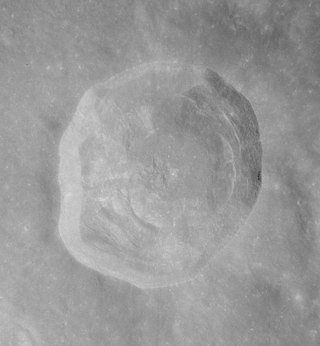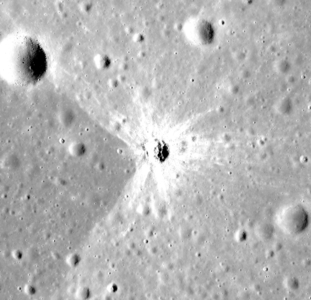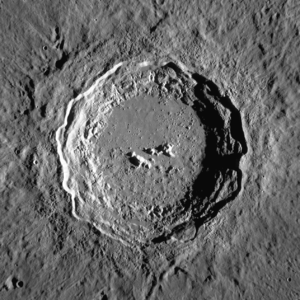
Tycho is a prominent lunar impact crater located in the southern lunar highlands, named after the Danish astronomer Tycho Brahe (1546–1601). It is estimated to be 108 million years old.

Oceanus Procellarum is a vast lunar mare on the western edge of the near side of the Moon. It is the only one of the lunar maria to be called an "Oceanus" (ocean), due to its size: Oceanus Procellarum is the largest of the maria ("seas"), stretching more than 2,500 km (1,600 mi) across its north–south axis and covering roughly 4,000,000 km2 (1,500,000 sq mi), accounting for 10.5% of the total lunar surface area.

Mare Cognitum is a lunar mare located in a basin or large crater which sits in the second ring of Oceanus Procellarum. To the northwest of the mare is the Montes Riphaeus mountain range, part of the rim of the buried crater or basin containing the mare. Previously unnamed, the mare received its name in 1964 in reference to its selection as the target for the successful impact probe Ranger 7, the first American spacecraft to return closeup images of the Moon's surface.

The Fra Mauro formation is a formation on the near side of Earth's Moon that served as the landing site for the American Apollo 14 mission in 1971. It is named after the 80-kilometer-diameter crater Fra Mauro, located within it. The formation, as well as Fra Mauro crater, take their names from a 15th-century Italian monk and mapmaker of the same name. Apollo 13 was originally scheduled to land in the Fra Mauro highlands, but was unable due to an in-flight technical failure.

The lunar geological timescale divides the history of Earth's Moon into five generally recognized periods: the Copernican, Eratosthenian, Imbrian, Nectarian, and Pre-Nectarian. The boundaries of this time scale are related to large impact events that have modified the lunar surface, changes in crater formation through time, and the size-frequency distribution of craters superposed on geological units. The absolute ages for these periods have been constrained by radiometric dating of samples obtained from the lunar surface. However, there is still much debate concerning the ages of certain key events, because correlating lunar regolith samples with geological units on the Moon is difficult, and most lunar radiometric ages have been highly affected by an intense history of bombardment.

Giordano Bruno is a 22-kilometre (14 mi) lunar impact crater on the far side of the Moon, just beyond the northeastern limb. It lies in an area that can be viewed during a favorable libration, although the area is viewed from the side and not much detail can be seen. It lies between the craters Harkhebi to the northwest and Szilard to the southeast.

Copernicus is a lunar impact crater located in eastern Oceanus Procellarum. It was named after the astronomer Nicolaus Copernicus. It typifies craters that formed during the Copernican period in that it has a prominent ray system. It may have been created by debris from the breakup of the parent body of asteroid 495 Eulalia 800 million years ago.

Aristarchus is a lunar impact crater that lies in the northwest part of the Moon's near side. It is considered the brightest of the large formations on the lunar surface, with an albedo nearly double that of most lunar features. The feature is bright enough to be visible to the naked eye, and displays unusually bright features when viewed through a large telescope. It is also readily identified when most of the lunar surface is illuminated by earthshine. The crater is deeper than the Grand Canyon.

A ray system comprises radial streaks of fine ejecta thrown out during the formation of an impact crater, looking somewhat like many thin spokes coming from the hub of a wheel. The rays may extend for lengths up to several times the diameter of their originating crater, and are often accompanied by small secondary craters formed by larger chunks of ejecta. Ray systems have been identified on the Moon, Earth, Mercury, and some moons of the outer planets. Originally it was thought that they existed only on planets or moons lacking an atmosphere, but more recently they have been identified on Mars in infrared images taken from orbit by 2001 Mars Odyssey's thermal imager.

Proclus is a young lunar impact crater located to the west of the Mare Crisium, on the east shore of the Palus Somni. Its diameter is 27 km. It was named after 5th century Greek mathematician, astronomer and philosopher Proclus.

Kepler is a lunar impact crater that lies between the Oceanus Procellarum to the west and Mare Insularum in the east. To the southeast is the crater Encke. Kepler is named for the 17th century German astronomer and mathematician Johannes Kepler.

Lalande is a small lunar impact crater that lies in the central part of the visible Moon, on the eastern edge of Mare Insularum. It was named after French astronomer Jérôme Lalande. The crater is surrounded by a high-albedo area of ejecta that extends into a ray system with a maximum radius of over 300 kilometers. The interior wall has a terrace system, and there is a small central rise at the midpoint of the floor. It was formed during the Copernican period of the moon extending from 1.1 billion years ago to the present. Its young age is indicated by the bright rays of ejecta surrounding the crater, its sharp features, and the relative lack of later impacts in its interior. The rays of ejecta from Lalande overlay the ejecta rays from Copernicus Crater, meaning it is younger than Copernicus, and thus no more than 800 million years old.

Lichtenberg is an isolated lunar impact crater located in the western part of the Oceanus Procellarum. The nearest crater of note is Briggs to the south.

Lunar craters are impact craters on Earth's Moon. The Moon's surface has many craters, all of which were formed by impacts. The International Astronomical Union currently recognizes 9,137 craters, of which 1,675 have been dated.

Necho is a lunar impact crater on the far side of the Moon, and therefore cannot be seen directly from the Earth. It lies to the northeast of the larger crater Langemak, about a crater diameter to the south-southwest of Bečvář and further east is Love.

The geology of the Moon is quite different from that of Earth. The Moon lacks a true atmosphere, and the absence of free oxygen and water eliminates erosion due to weather. Instead, the surface is eroded much more slowly through the bombardment of the lunar surface by micrometeorites. It does not have any known form of plate tectonics, it has a lower gravity, and because of its small size, it cooled faster. In addition to impacts, the geomorphology of the lunar surface has been shaped by volcanism, which is now thought to have ended less than 50 million years ago. The Moon is a differentiated body, with a crust, mantle, and core.

The Kuiper quadrangle, located in a heavily cratered region of Mercury, includes the young, 55-km-diameter crater Kuiper, which has the highest albedo recorded on the planet, and the small crater Hun Kal, which is the principal reference point for Mercurian longitude. Impact craters and basins, their numerous secondary craters, and heavily to lightly cratered plains are the characteristic landforms of the region. At least six multiringed basins ranging from 150 km to 440 km in diameter are present. Inasmuch as multiringed basins occur widely on that part of Mercury photographed by Mariner 10, as well as on the Moon and Mars, they offer a potentially valuable basis for comparison between these planetary bodies.

South Ray crater is a small crater in the Descartes Highlands of the Moon photographed from the lunar surface by the astronauts of Apollo 16. The name of the crater was formally adopted by the IAU in 1973.

Volcanism on the Moon is represented by the presence of volcanoes, pyroclastic deposits and vast lava plains on the lunar surface. The volcanoes are typically in the form of small domes and cones that form large volcanic complexes and isolated edifices. Calderas, large-scale collapse features generally formed late in a volcanic eruptive episode, are exceptionally rare on the Moon. Lunar pyroclastic deposits are the result of lava fountain eruptions from volatile-laden basaltic magmas rapidly ascending from deep mantle sources and erupting as a spray of magma, forming tiny glass beads. However, pyroclastic deposits formed by less common non-basaltic explosive eruptions are also thought to exist on the Moon. Lunar lava plains cover large swaths of the Moon's surface and consist mainly of voluminous basaltic flows. They contain a number of volcanic features related to the cooling of lava, including lava tubes, rilles and wrinkle ridges.





























